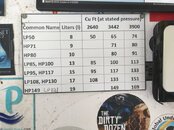Cdncoldwater
Contributor
Unfortunately, some (all?) of the gas compressibility math isn’t covered in any TDI/IANTD/SSI/Paditec tech instructor manuals that I know of domestically. It’s much more a problem with high helium mixes or once you push past 200ish bar.
Very likely and I'm definitely not any type of authority, I'm just a rec diver with PADI and SDI. I'm surprised that the instructor manuals in those International dive organizations aren't the same at least within the specific organization such as TDI for example. I don't consider PADI tec at the same level as TDI or IANTD. Fortunately the instructor I have has a lot experience in this area. We talked a bit about z-factor and actual capacities the other day after looking at your points and my take away was at the rec level it is less critical vs tec with deco obligations, team air responsibilities (OOA, equipment failure etc). I was surprised that the tanks I'm discussing are stamped 2400 PSI but the literature lists working pressure with the + 10% to get "50". Very good information for me and I am adjusting my spreadsheet regarding cf and psi. Subconsciously I was already using a basic form of the z-factor as I do a "surface plan" but check for the psi (capacity) change once my tanks have been in the water to get my true capacity for that dive and adjust my plan accordingly. I regulate all my diving by psi not cf while diving through my SPG. I know that SPGs are not 100% accurate however I'm diving thirds, and am comfortable with the level of accuracy in the information they provide. I think the OP would be in the same situation as me at this point.




